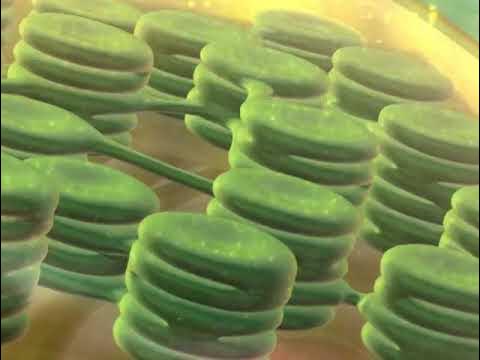Comparing animal and plant cells | Cells and organisms | Middle school biology | Khan Academy
Summary
TLDRThis educational video explores the similarities and differences between animal and plant cells. Both cell types share a cell membrane, cytosol, nucleus, and mitochondria, but plant cells also possess a cell wall for added structure and chloroplasts for photosynthesis. The video uses the analogy of a lion and a fern to illustrate these concepts, highlighting how despite their distinct appearances, their cellular structures have both commonalities and unique features that define their functions.
Takeaways
- 🔬 Both animal and plant cells share common features such as a cell membrane, cytosol, nucleus, and mitochondria.
- 🌿 Plant cells have a unique cell wall that provides structure and rigidity, unlike animal cells.
- 🍃 Chloroplasts are special organelles in plant cells that give them their green color and are responsible for photosynthesis.
- 🐾 The nucleus in both cell types acts as the cell's information database, storing genetic information.
- ⚡ Mitochondria in both animal and plant cells function as energy factories, breaking down sugars to release energy.
- 🌱 Plant cells convert sunlight into chemical energy through photosynthesis, a process that does not occur in animal cells.
- 🥗 The cell wall in plant cells contributes to their firmness, as opposed to the softness of animal tissues.
- 🔄 There is a symbiotic relationship between chloroplasts and mitochondria in plant cells, where one produces sugars and the other converts them into energy.
- 🧬 The cell membrane in both animal and plant cells regulates the entry and exit of substances, maintaining cellular homeostasis.
- 🌳 The differences in cell structure between plant and animal cells contribute to their distinct functions and characteristics in living organisms.
Q & A
What is the primary function of the cell membrane in both animal and plant cells?
-The cell membrane acts as a gate to control what enters and leaves the cell.
What is the role of the cytosol in both animal and plant cells?
-The cytosol is a jelly-like substance that contains organelles or small compartments with specific functions inside the cell.
What are the two common organelles found in both animal and plant cells?
-The two common organelles found in both animal and plant cells are the nucleus and the mitochondria.
What is the function of the nucleus in a cell?
-The nucleus serves as an information database to store the cell's genes.
How do mitochondria contribute to the cell's energy production?
-Mitochondria act as factories to break down sugars and release energy that the cells can use.
What is the main difference between plant and animal cells in terms of structural components?
-Plant cells have an additional layer called a cell wall that surrounds the cell membrane, which is not present in animal cells.
What is the purpose of the cell wall in plant cells?
-The cell wall provides structure and stiffness to the plant cell, making it more rigid compared to animal cells.
What are chloroplasts and what is their primary function in plant cells?
-Chloroplasts are special organelles in plant cells that give plants their green color and are the site of photosynthesis, where plants make their own food in the form of sugars.
How do chloroplasts and mitochondria work together in plant cells?
-Chloroplasts make sugars through photosynthesis, and mitochondria convert the sugars into energy that the plant can use.
Why don't animal cells have chloroplasts?
-Animal cells do not have chloroplasts because they do not perform photosynthesis to make their own food; instead, they obtain energy by consuming other organisms.
What is a key takeaway from the comparison of animal and plant cells in terms of their functions?
-A key takeaway is that while both cell types share basic structures like the cell membrane, cytosol, nucleus, and mitochondria, the presence of a cell wall and chloroplasts in plant cells distinguishes them from animal cells and plays a crucial role in their distinct functions.
Outlines

This section is available to paid users only. Please upgrade to access this part.
Upgrade NowMindmap

This section is available to paid users only. Please upgrade to access this part.
Upgrade NowKeywords

This section is available to paid users only. Please upgrade to access this part.
Upgrade NowHighlights

This section is available to paid users only. Please upgrade to access this part.
Upgrade NowTranscripts

This section is available to paid users only. Please upgrade to access this part.
Upgrade Now5.0 / 5 (0 votes)





